Removing air from the heating system: how to release the airlock
The appearance of air pockets in the heating system is accompanied by uneven heating of devices and alarming noise in the pipeline. The coolant moves jerkily along the circuit, increasing the likelihood of water hammer.Agree, any sensible owner would like to exclude these phenomena.
The listed negatives can be eliminated and prevented by a simple action - removing air pockets from the heating system. How to do it? How to correctly assemble the circuit, what devices should be installed so that the air is removed in a timely manner, you will learn from our proposed article.
The information presented for review is based on regulatory documentation. We have described all possible methods used against the formation of air jams. To optimize perception, the material is supplemented with photo selections, diagrams, and videos.
The content of the article:
Why are air locks dangerous?
Air getting inside water heating system - a very common phenomenon. And you should respond to it immediately. While some air in the system may not seem dangerous, it can often cause more serious problems.
And sometimes airiness of the radiator or pipes makes it possible to identify breakdowns or flaws in the installation of the heating system.
The presence of air locks usually manifests itself in the form of uneven heating of individual system elements, for example, radiators.
If the device is only partially filled with coolant, its operation can hardly be called effective, since the room does not receive part of the thermal energy, i.e. doesn't warm up.
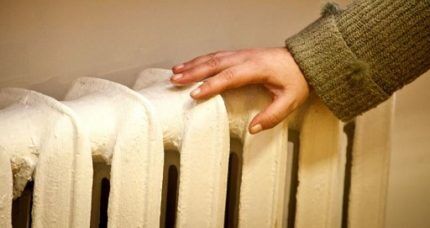
If air has accumulated in the pipes, it prevents the normal flow of coolant. As a result, the operation of the heating system may be accompanied by quite loud and unpleasant noise.
Sometimes part of the system begins to vibrate. The presence of air in the circuit causes the activation of various chemical processes, for example, it can cause the decomposition of calcium and magnesium bicarbonate compounds.
This leads to the formation of carbon dioxide, which disrupts the acid-base balance of the coolant. Increased acidity increases the corrosive effect on heating system elements, which can lead to a noticeable reduction in their service life.
In addition, chemical processes occurring under the influence of high temperatures cause the deposition of limestone deposits on the walls of pipes and radiators, creating a dense coating.
As a result, the pipe clearance decreases, the characteristics of the heating system change, and it operates with less efficiency. A large amount of limescale can completely clog the pipes; they will have to be cleaned or even completely replaced.
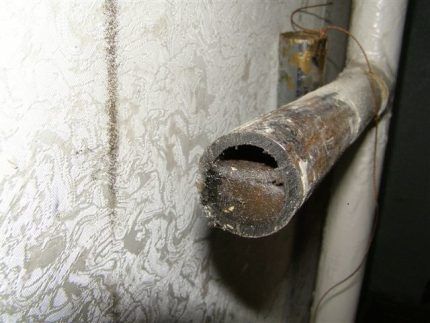
If in heating circuit included circulation pump, the presence of air in the system can have a detrimental effect on its operation. The bearings of this device are designed to withstand constant exposure to an aquatic environment. If air gets into the pump, the bearing will run dry, causing it to overheat and fail.
Read the article: 22 best automatic and manual air vents: review, quality, price.
Causes of excess air
There are many reasons for the appearance of air; it is quite difficult to completely avoid this phenomenon. Still, the factors that cause air pockets to form in the heating system should be studied in order to minimize their impact on the system.
Most often, air enters the system:
- if the heating was initially installed incorrectly;
- if the rules for filling the heating circuit with water are not followed;
- if the tightness of the connection of individual elements of the system is broken;
- when the system lacks or incorrectly uses air exhaust devices;
- after repair work;
- when replacing the lost volume of coolant with cold water.
Improper installation of the heating system leads to its airing in cases where the pipes are laid with an incorrect slope, form loops, etc. It is best to track such areas at the design stage of autonomous heating.
Filling the circuit with water should be done according to the principle: the larger the volume of coolant, the lower the rate of its entry into the system. If water enters too quickly, in certain areas it can become a spontaneous version of the water seal, preventing the natural process of displacing air from the circuit.
In places connections of pipes and radiators Leaks often occur. Sometimes the crack is so small that the water escaping from it evaporates almost immediately. The hole remains unnoticed, and air gradually penetrates through it, replacing the lost volume of water.
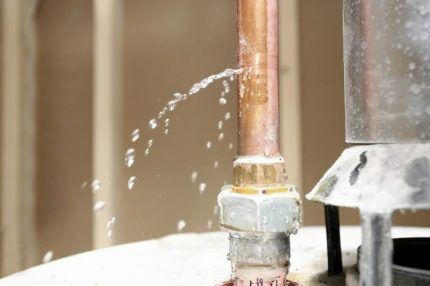
Since in one way or another the circuit may still become air-filled, when designing the heating system, it is necessary to provide for the installation of special devices designed to bleed air from the heating system. If you already have such air vents, but they do not give the desired effect, some of them may be broken and require replacement.
It also happens that air removal devices are ineffective due to their incorrect installation or insufficient quantity. It is inevitable that air will enter the system after it is repaired. In this case, it will be necessary to carry out de-airing measures.
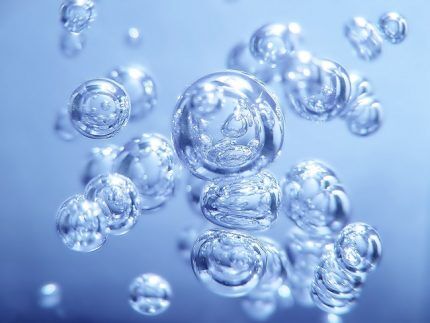
If part coolant volume lost, it needs to be replenished. Fresh water, unlike what is already in the system, contains a certain amount of air dissolved in it. When heated, it releases in the form of small bubbles and accumulates, forming plugs.
If fresh coolant has been added to the system, after a while it will not hurt to make sure that it is not air-filled anywhere.
Methods for removing air from the system
So, in order to avoid airing the heating system, it is necessary to design and install it correctly, clean it in a timely manner and fill it with coolant without unnecessary haste.
Even so, one or more air pockets may still appear in the system. What to do in this case? The procedure largely depends on the design features of the heating system.
Method #1 - following installation rules
In schemes with natural circulation of coolant with upper distribution, air is removed through open expansion tank. When installing such a system, the supply line is installed so that it rises vertically to the tank.
A container that provides room for expansion of the coolant when heated is placed at the highest point of the system, which ensures the natural movement of the liquid along the heating circuit.
The return line should also be installed with a slope that facilitates the natural movement of coolant flow.
If the system is installed correctly, the air trapped inside the circuit will be gradually displaced upward by hot water and leave the pipeline through the surface of the expansion tank, which is freely communicating with the atmosphere.
Method #2 - installing air vents
The scheme for removing air from forced circulation circuits differs from the previous type. An open expansion tank is installed at the top point of such a system, and a closed one is placed in front of the return boiler entrance.
In such a system, the supply line should not have a slope, because the movement of the coolant is stimulated by a pump and other devices are used to relieve air pockets.
To remove air from the system, special automatic air vents are provided, installed at the highest points of the system and at pipeline turns.
Used to remove plugs from radiators Mayevsky cranes. In the same way, air is removed from the heating circuit with natural circulation, but with lower pipe routing.
If installed correctly, the procedure for removing unnecessary air from the system is very simple; it boils down to opening the appropriate taps and closing them after the air pockets formed in the heating system are released. Automatic air vents do not need to be opened at all. They are triggered by pressure changes.
Closed-type heating circuits are necessarily supplemented with automatic air vents.
They are installed along the entire circuit at certain points, which allows you to remove the air plug from the circuit locally, without waiting for the air to move to the highest point of the system.This scheme is called a multi-stage deaeration system.
The idea is to ensure that every part of the heating circuit can be vented. Usually each radiator equipped with a manually controlled air exhaust device, for example, a Mayevsky valve.
If the radiator is hot at the bottom and its upper part remains cold, then the accumulated air must be removed from it.
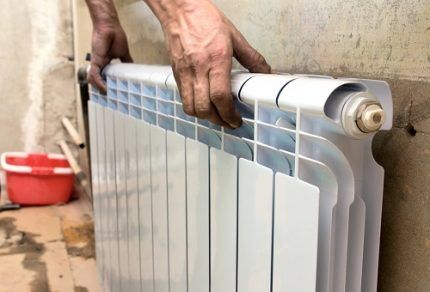
To do this, you will need a wrench or screwdriver, as well as a container to collect water and a rag for the floor. Using tools, the Mayevsky tap is opened and a container is placed under it. The air comes out with a characteristic hiss.
When the plug is removed, water will flow from Mayevsky’s tap. The tap can now be closed. In most cases, this simple procedure allows you to restore uniform distribution of coolant throughout the radiator.
Automatic air vents are of horizontal and vertical types. They are installed in places where the likelihood of an air lock is greatest. These may be areas where the heating pipe makes a turn, loop, etc.
Airiness of the heating system is more typical for the upper floors of the building, so special attention should be paid to installing air exhaust devices here.
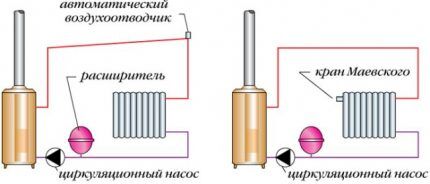
When using automatic air vents, it is important to monitor the pressure level in the system.In addition, such devices are highly sensitive to contamination.
To extend the life of automatic air vents, you should install good filters and regularly flush the heating circuit.
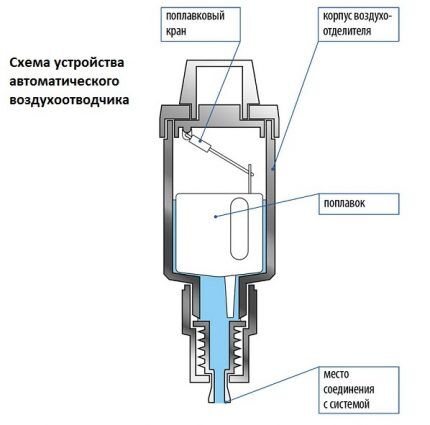
To determine the place where air has accumulated, radiators and pipes are first simply felt. Where the heating temperature is noticeably lower, there is usually an air lock.
Another way to identify an airy place is to tap the outline. They use a small metal object with which they strike carefully. In places where air accumulates, the sound will be louder.
Method #3 - high heating of the coolant
Sometimes, to naturally remove excess air from the heating circuit, it is enough to heat the coolant strongly. High temperature stimulates the process of air release and its movement through the system. It is allowed to heat the water in the heating system up to 100 degrees.
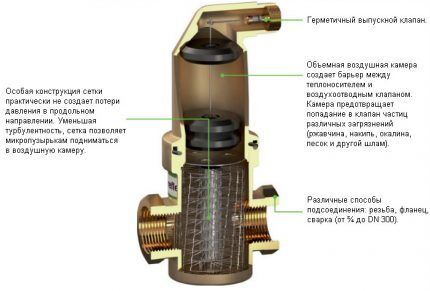
If the formation of air pockets is observed in the system again and again, all joints should be examined for leaks.
Near the place where the air lock forms, you will almost certainly find a small gap from which water flows out imperceptibly and into which air bubbles leak. Sealing such a gap or crack will solve the problem.
The most vulnerable to air locks are considered to be aluminum radiators. The interaction of hot coolant with the material of the device causes the development of corrosion processes, which are accompanied by the release of gaseous substances.
If airiness of such a radiator is observed again and again, it makes sense to replace it with a more modern device with an internal anti-corrosion coating.
Filling the heating circuit with coolant
In order for the heating system to work correctly, it must be flushed and then refilled with water. It is often at this stage that air leaks into the circuit. This occurs due to incorrect actions while filling the contour. In particular, air can be trapped by too fast a flow of water, as mentioned earlier.
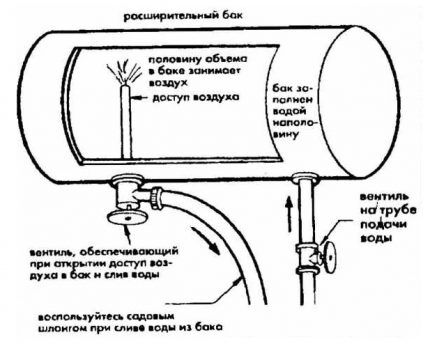
Besides, correct contour filling It also promotes faster removal of that part of the air masses that are dissolved in the coolant. To begin with, it makes sense to consider an example of filling an open heating system, at the highest point of which the expansion tank is located.
Such a circuit should be filled with coolant starting from its very bottom. For these purposes, a shut-off valve is installed at the bottom of the system, through which tap water is supplied to the system.
A properly designed expansion tank has a special pipe that protects it from overflow.
A hose of such length should be attached to this pipe that its other end is brought out into the area and is located outside the house. Before you start filling the system, you should take care of the heating boiler. It is recommended to disconnect it from the system at this time so that the protective modules of this unit do not work.
Once these preparatory steps have been completed, you can begin filling the contour. The tap at the bottom of the circuit through which tap water flows is opened so that water fills the pipes very slowly.
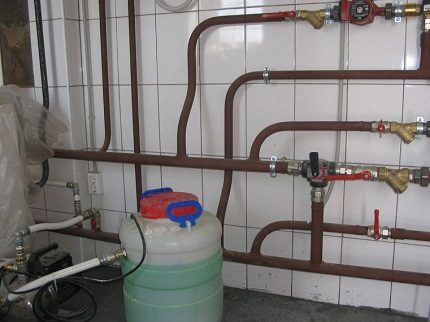
Slow filling is continued until water flows through the overflow hose leading outside. After that water tap should be closed. Now you should go through the entire system and open the Mayevsky valve on each radiator to bleed air.
Then you can reconnect the boiler to the heating system. It is also recommended to open these taps very slowly.While the boiler is filling with coolant, you can hear a hissing sound produced by the air release safety valve.
This is normal. After this, you need to add water to the system again at the same slow pace. The expansion tank should be approximately 60-70% full.
After this, it is necessary to check the operation of the heating system. The boiler is turned on and the heating system is warmed up. Radiators and pipes are then examined to identify areas where heating is missing or insufficient.
Insufficient heating indicates the presence of air in the heating radiators; it must be bled again through the Mayevsky taps. If the procedure for filling the heating circuit with coolant was successful, do not relax.
For at least another week, the operation of the system should be closely monitored, the water level in the expansion tank should be monitored, and the condition of pipes and radiators should be checked. This will allow problems to be quickly resolved.
In a similar way, closed-type systems are filled with coolant. Water should also be supplied to the system at low speed through a special tap.
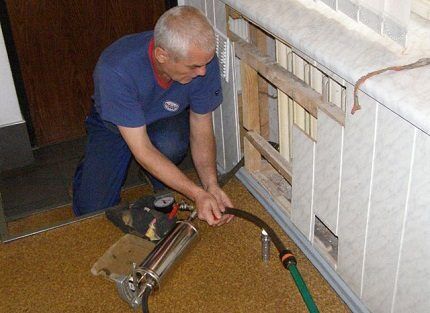
But in such systems, pressure control is an important point. When it reaches a level of two bars, you should turn off the water and bleed air from all radiators through the Mayevsky taps. At the same time, the pressure in the system will begin to decrease. It is necessary to gradually add coolant to the circuit in order to maintain pressure at two bar.
It is difficult to perform both of these operations alone.Therefore, it is recommended to complete the filling of a closed contour together with an assistant. While one person bleeds air from the radiators, his partner monitors the pressure level in the system and immediately corrects it. Collaborative work will improve the quality of this type of work and reduce its time.
Conclusions and useful video on the topic
Video #1. A visual demonstration of the process of removing excess air from a radiator using a Mayevsky tap:
Video #2. How to bleed air from the heating circuit that does not escape through the air vent:
Air entering the heating system reduces its efficiency and can cause damage to some components..
To successfully cope with this problem, you must initially install the heating correctly or correct existing flaws. In addition, it is necessary to install air exhaust devices and follow the rules for operating heating systems.
Please write comments if you have any questions while reading the information provided. We are waiting for your stories about your own heating device, about installing devices for removing air from the system. We invite you to comment on the material in the block located below the text of the article.




I am engaged in the repair and installation of heating communications. Very often a problem arises such as airiness of the system. People complain that the radiators are warm in one room and completely cold in another. The problem is easily solved: you just need to bleed the air in the circuit. The article is very informative, but it still doesn’t hurt to know why such situations arise.
I live in a private house, and at one point something started clicking in the pipes.They suggested that it could be an air lock. It was decided to expel it through the drain valve. They didn’t open it completely, but turned up the heating at full power. I began to monitor the water in the expansion tank, periodically adding water so that air did not get into the system again. So far so good, let's see next season.
What to do: the last battery in my private house is cold. I drained the water from the bottom of the return line, water comes out without air, it didn’t help.
What to do if some of the batteries are cold? I bleed air through Mayevsky's taps and it didn't help.
Hello. Ask your question in more detail, please. What exactly is the “part of the batteries”, what heating circuit do you have, and so on. Maybe it's not in the air.
Hello. I would like to see a detailed diagram of your heating and find out how long this has been happening. As reasons, we can suggest problems with the location of the bypass, when it is too far from the return or is not embedded in the wiring, but in the branches. As a result, the pressure is not enough for the coolant to enter the last radiator. There may also be a lack of balancing. Usually solved by installing thermostats and taps.
We have a house from the 60s, a five-story building and the heating, of course, was done very stupidly, the wiring is of the old type. If the battery is airy, then that's it, it's cold. Only those who live on the 5th floor can vent the air, because the pipe enters there, and from there it is distributed to each apartment and it is coldest on the 2nd floor. Is there any way out of this situation?
Hello.In general, this is a headache for the management company, since the property is common property. Write a statement addressed to your boss about non-compliance with temperature standards in the apartment, although this must be done during the heating season for examination. In general, taps should be installed in the attic.
Resolution of the State Construction Committee of the Russian Federation dated September 27, 2003 N 170 “On approval of the Rules and Standards for the Technical Operation of the Housing Stock”:
«5.2.12. Personnel of the housing maintenance organization must systematically monitor the operation of heating systems during the heating season.
5.2.15. The release of air from central heating systems through the air outlet valves on the heating devices should be done periodically, each time the inlet pressure drops below the static pressure level of the system, as well as after it is recharged, in accordance with the instructions.
5.2.17. Reliable operation of water heating systems must be ensured by the following work: - systematic removal of air from the heating system
«.